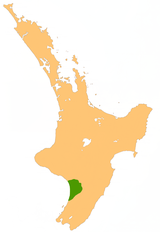| This article does not cite any sources. Please help improve this article by adding citations to reliable sources. Unsourced material may be challenged and removed. Find sources: "Manawatū Plains" – news · newspapers · books · scholar · JSTOR (December 2009) (Learn how and when to remove this message) |

The Manawatū Plains is an area of low-lying land in New Zealand, located on the floodplains of the Manawatū and Rangitīkei Rivers. It is some of the most fertile lands in the southwestern North Island.
Stretching from the northern Horowhenua around Levin in the south to Marton in the north, the triangular area of land extends inland from the South Taranaki Bight to almost as far as Ashhurst at the mouth of the Manawatū Gorge. It covers an area of around 1,000 square kilometres (390 sq mi).
In the south, around Lake Horowhenua, the plains were once an extensive wetland, which has been largely drained and turned into profitable dairy farming land. There are conservation moves in progress to restore some of these wetlands to their former state.
Further north, the plains provide the basis for the economy which drives the city of Palmerston North and the towns of Foxton, Feilding, and Bulls, all of which rely on the agricultural dollar to an extent.
As floodplains, the land is not always entirely dry. Although the area receives slightly below the national average rainfall, floods can occur, as happened around the township of Tangimoana in early 2004.
| Manawatū River | |
|---|---|
| Source: Ruahine Range. Flows into: South Taranaki Bight | |
| Administrative areas | |
| Towns and settlements (upstream to downstream) | |
| Major tributaries (upstream to downstream by confluence) | |
| Other features (upstream to downstream) | |
| Longest New Zealand rivers |
|
40°23′S 175°25′E / 40.38°S 175.41°E / -40.38; 175.41
Categories: